Weddings in Romania are special ceremonies that represent not only the union of two individuals but also the transmission of deep-rooted cultural values and traditional symbols from generation to generation. Especially in rural areas, these traditions are still vividly preserved and are not just marriage celebrations but also social events that showcase community solidarity, family ties, and folk beliefs. Adorned with music, dance, handmade decorations, and rituals, these ceremonies highlight the folkloric richness of Romania.
Traditional Romanian weddings consist of many stages, from the preparation process to post-wedding celebrations, and each step has its own symbolic meaning. From the bride being taken from her home to the “bride kidnapping” game, from the bread-breaking ceremony to the dowry display, every detail is closely linked to the values of the community. In this article, we will explore the origins and symbols of traditional Romanian wedding rituals and how these ceremonies are kept alive today.
Bride Request (Cererea Miresei): Knocking on the Family’s Door is an Art

The traditional wedding process in Romania often begins with the “Cererea Miresei,” or the bride request. This ritual involves the groom and his family officially visiting the bride-to-be’s home to declare their intention of marriage and to ask for the family’s blessing. However, this is not merely a conversation; it is a symbolic ceremony in which respect, courtesy, and tradition intertwine. Typically, the groom’s family brings wine, bread, or symbolic gifts to express goodwill to the bride’s side. The conversations, humorous dialogues, and polite requests during the visit add joy and meaning to the ceremony.
In some regions, this ritual turns into a small theatrical performance: the bride’s family jokingly presents the groom with several “wrong” brides (an old woman, a child, or a neighbor’s daughter), testing his patience until he finds the right one. This tradition not only strengthens the warm communication between the families but also reflects the society’s value placed on the institution of marriage. When the real bride is finally revealed, both families proceed to the next steps of the process with unity and happiness. This ritual symbolizes that marriage in Romania is not just a union between two individuals but a strong bond between two families.
Promise and Engagement: The Celebration Before Marriage
In Romania, the “promise” and engagement ceremony are among the most significant steps in the journey toward marriage. Following the bride request, this phase is the first celebration that formalizes the union of the two families and announces it to the community. The engagement is usually organized as a large family gathering, where the couple’s coming together is celebrated in a way believed to bring happiness and abundance according to folk beliefs. The groom’s family brings various gifts to the bride’s side, traditionally including jewelry, sweets, household items, and symbolic objects.
During the ceremony, the groom typically places a ring on the bride’s finger, and the elders of the families bless the moment, offering spiritual support for the marriage process. The engagement allows not only the couple but also the two families to bond. In some regions, it takes place in the atmosphere of a mini-wedding, complete with traditional folk music, dancing, and local dishes. This celebration not only heralds the major step the couple will take in the future but also symbolizes the value of commitment and promise before marriage in Romanian culture.
Bride Taking Ceremony: The Symbols Behind the Joyful Event
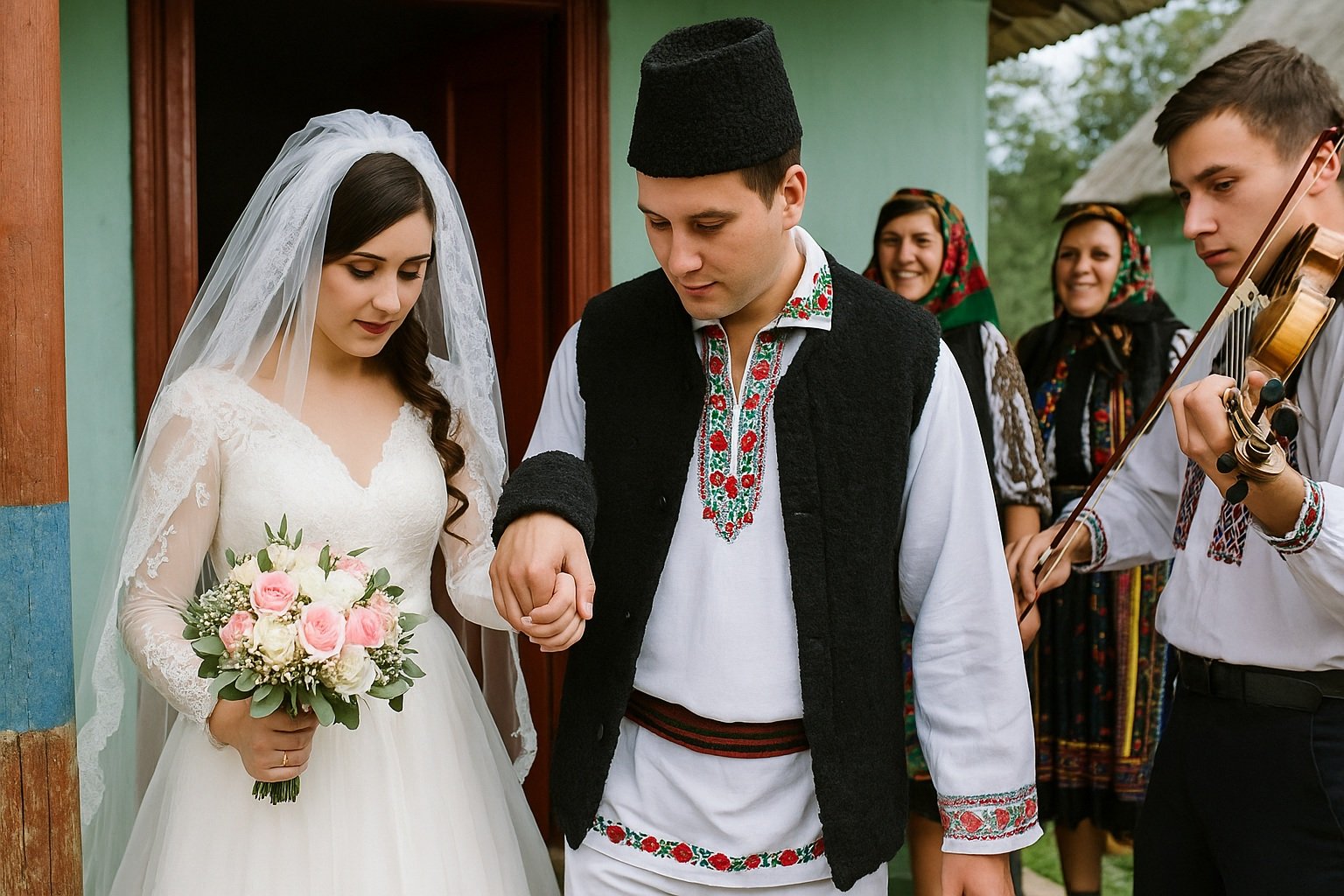
One of the most colorful and symbolic moments of traditional Romanian weddings is the “bride taking” ceremony. On the morning of the wedding day, the groom arrives at the bride’s house accompanied by his family and friends, along with music. They are usually joined by local musicians, dancers, and decorated cars. Upon arrival at the bride’s door, their entrance is symbolically “resisted” by the bride’s family, often met with cheerful bargaining, jokes, and traditional songs. This scene is both a form of entertainment and an expression of respect and affection toward the bride’s family.
During the ceremony, before the bride is taken from her home in her traditional attire, she shares an emotional farewell with her family. This moment symbolizes both parting and the transition to a new life. In some regions, a symbolic veil is placed on the bride’s head before leaving the house, or a prayer is recited by her mother. Once the groom takes the bride, the convoy sets off again toward the wedding venue with music. The bride taking ritual in Romanian culture symbolizes the strength of family bonds and the idea that marriage is a serious yet joyful journey.
The “Kidnapping” of the Bride Tradition: Entertainment or a Test?
The tradition of “bride kidnapping,” which is quite common in Romanian weddings, is one of the playful and theatrical rituals that adds color to the ceremony. In this tradition, the bride is “kidnapped” during the wedding by friends or guests and is usually taken to a nearby café, bar, or symbolic location. When the groom realizes the bride is missing, he begins a quest to retrieve her. To win her back, the groom must complete small tasks, pay a symbolic ransom, or answer humorous questions. While providing entertaining moments for the guests, this game humorously represents the groom’s loving and determined effort to reclaim his “bride.”
The bride kidnapping tradition shows that Romanian weddings are not just formal ceremonies but also elements of creativity and folk theater. Although intended as a joke, the tradition symbolizes the couple’s bond. According to some interpretations, it also serves as a humorous test of the groom’s responsibility to “look after” his bride. Still practiced even at modern city weddings, this tradition highlights the vibrancy of Romanian wedding culture and the community’s sense of humor.
Bride’s Crown and Veil Ceremony: A Symbol of Purity and Transition into Womanhood
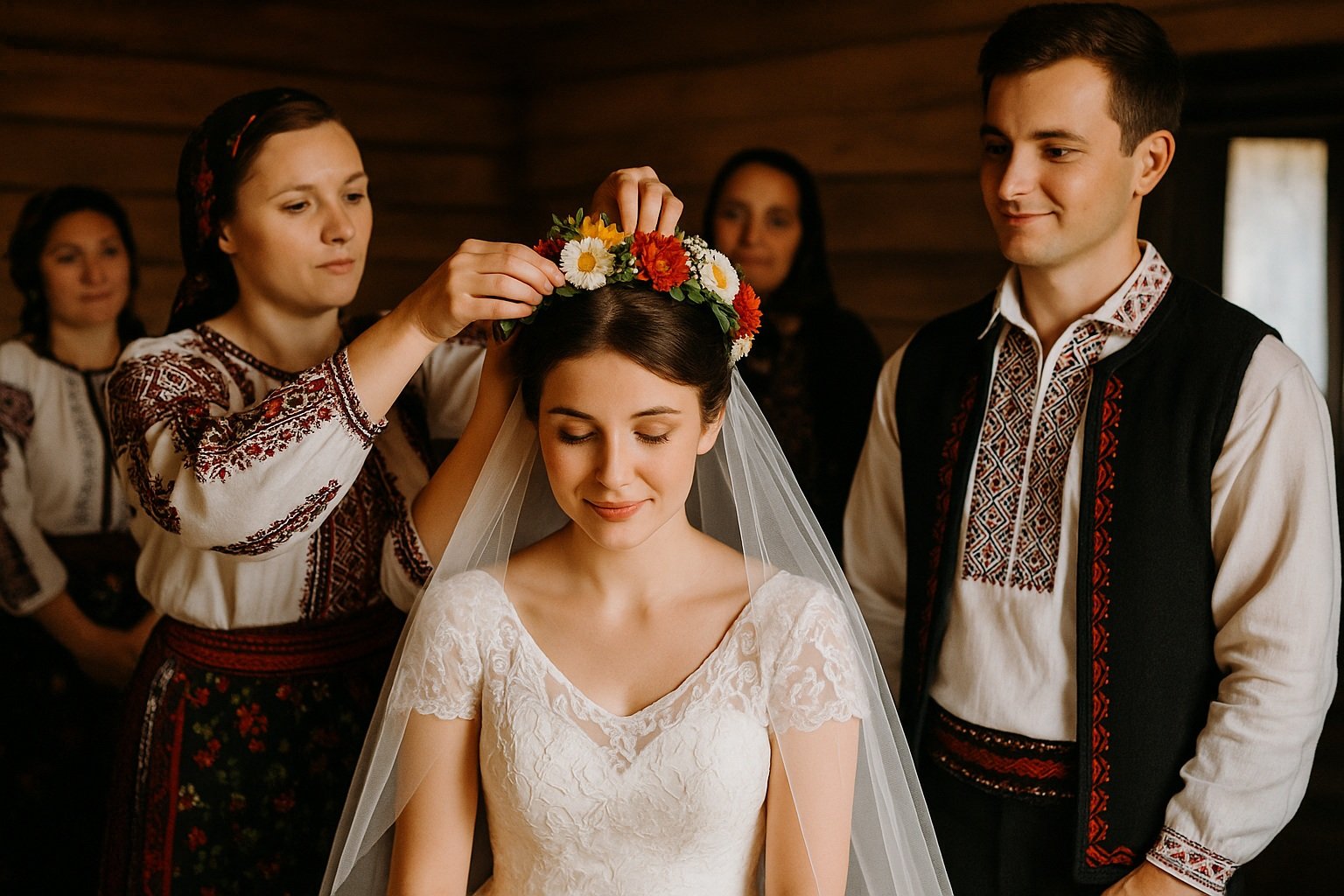
In traditional Romanian weddings, the “bride’s crown and veil ceremony” is one of the most meaningful moments symbolizing the transition from girlhood to womanhood. In this ritual, the floral crown or embroidered cloth on the bride’s head is removed during or at the end of the wedding and replaced with a traditional headscarf or accessories specific to married women. This change symbolizes that the bride is now a married woman and has stepped into a new life role. The ceremony is typically performed with music under the guidance of the ceremony master, and in some regions, the mother-in-law plays an active role.
This symbolic change of headwear emphasizes the significance of the veil as a representation of purity and marks the bride’s transition into the responsibilities of married life. Emotional moments are often experienced during the ceremony as the bride bids farewell to her family and single life, while the guests celebrate the transition with applause. With variations across different regions of Romania, this ritual remains one of the most impressive and symbolic highlights of the wedding.
Shoe Filling Ritual: Who is the Next to Marry?
One of the fun and symbolic traditions in Romanian weddings is the “shoe filling” ritual. In this custom, the bride’s close friends or unmarried girls take one of her shoes and fill it with coins, notes, flower petals, or small pieces of paper with wishes written on them. The purpose of the ritual is to predict the next bride-to-be based on whether the shoe stays on the bride’s foot without falling off despite the added contents. If a wish or coin falls out, it is believed that the girl who placed it will get married soon.
This symbolic game adds joy to the wedding atmosphere and is especially popular among young women. Beneath the ritual lies the belief that marriage is a matter of fate or order. The shoe filling tradition not only strengthens bonds of friendship but also provides a fun way to share hopes, wishes, and dreams about marriage. Even today, this custom continues to be practiced vividly, especially in rural areas.
Wedding Procession (Alaiul de Nuntă): Music, Dance, and Colorful Attire
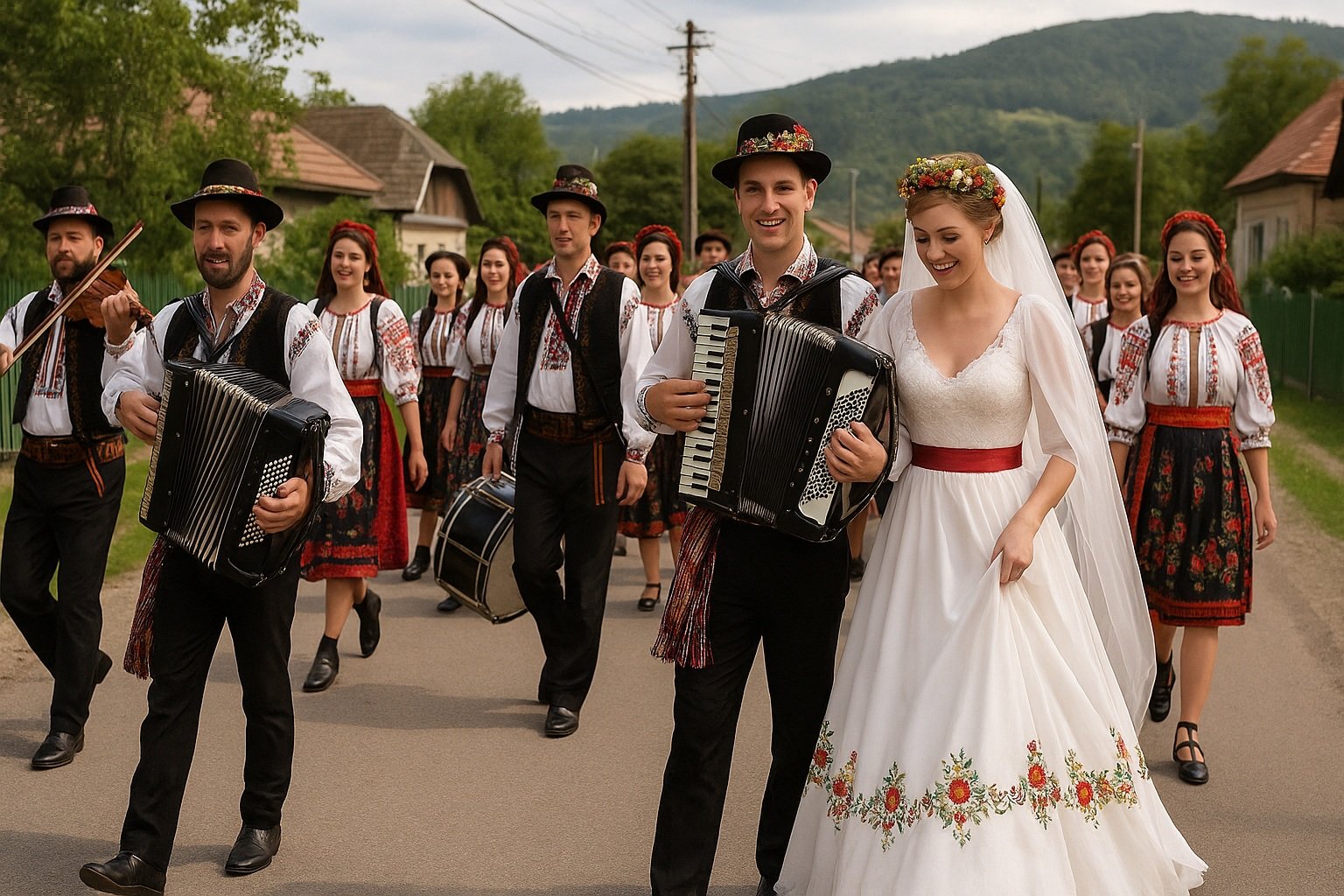
One of the most lively and striking parts of traditional Romanian weddings is the “Alaiul de Nuntă,” or the wedding procession. This procession begins with the groom’s family and friends, accompanied by musicians, heading to the bride’s house and continues through the streets of the town or village during the wedding. Participants wear traditional folk attire: women dress in embroidered skirts, white blouses, and headscarves, while men wear striped trousers and vests. This colorful parade moves forward with singing and dancing to the sounds of flutes, violins, and drums, spreading the joy of the wedding to those around.
The wedding procession is not only a joyful march but also a public announcement of the marriage. Every guest who joins the procession shares in the couple’s happiness; from children to the elderly, everyone gets caught up in the rhythm of the music. In some regions, traditional folk dances are performed during the procession, and well-wishes are offered to the bride and groom. This ceremony symbolizes the social aspect of the wedding and the spirit of community, while also keeping Romania’s rich folkloric heritage alive. Even today, this tradition is preserved as a nostalgic element in modern weddings, even in city centers.
Bread Breaking Ceremony: Who Will Have the Final Say?
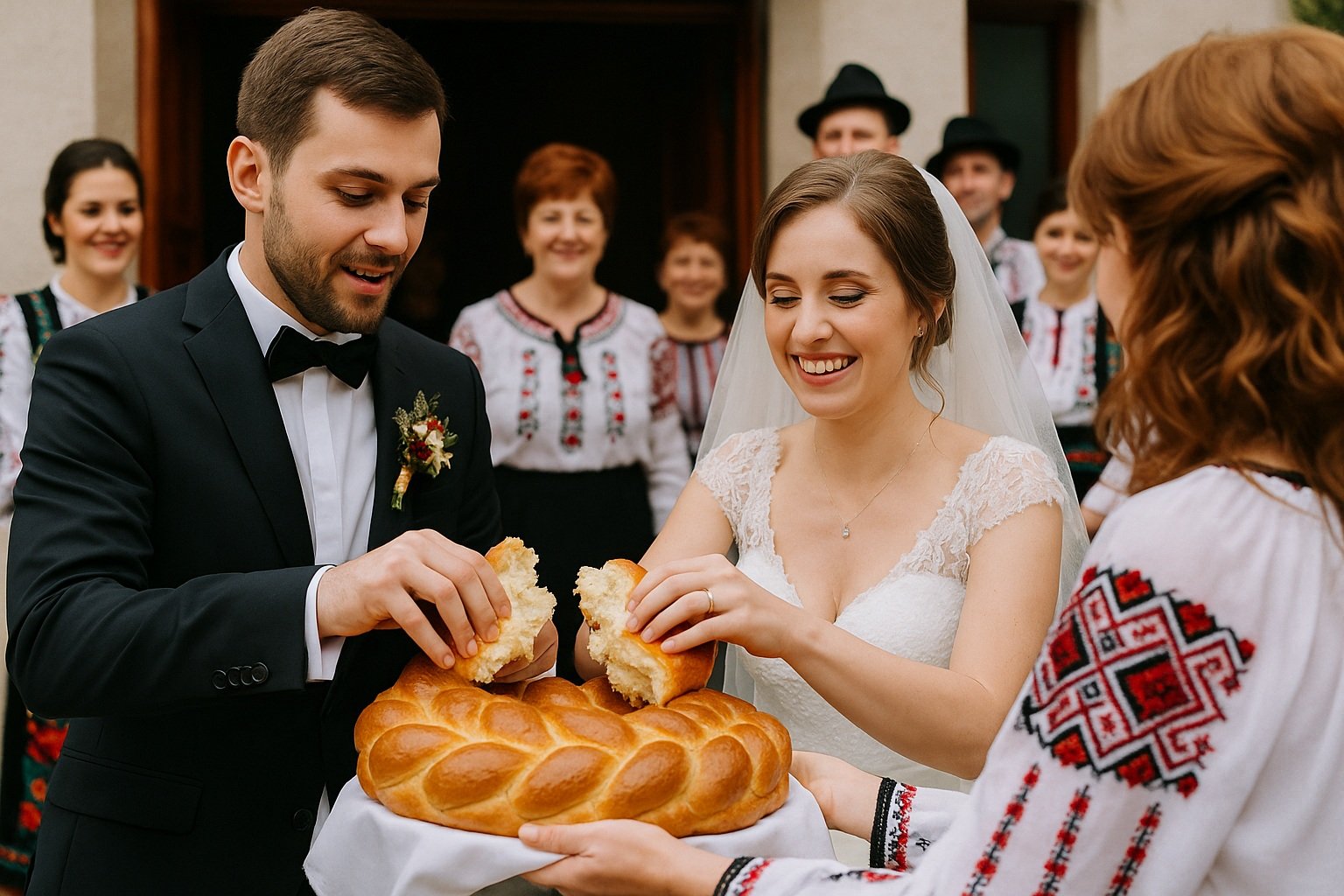
One of the most enjoyable and meaningful rituals in traditional Romanian weddings is the “bread breaking ceremony.” In this ritual, the bride and groom are given a large, round loaf of bread and attempt to break it in half at the same time. The goal is to see who gets the larger piece. According to folk belief, the one who gets the bigger piece will “have the final say” in the marriage, symbolizing the dominant character in the family. This tradition includes not only cheerful competition but also a touch of traditional humor regarding marital roles.
The ceremony is usually held before the wedding meal begins or as the couple enters the wedding venue. Guests watch this moment with excitement, applaud, and cheerfully react to the result. In some regions, the bread is later dipped in salt and fed to the couple, symbolizing unity in the face of hardship and the sharing of both the sweet and the salty aspects of life. The bread breaking ritual is both a symbolic start to the marriage and a vivid example of folk humor in Romanian culture.
Dowry Display: Family Honor Hidden in Handcraftsmanship
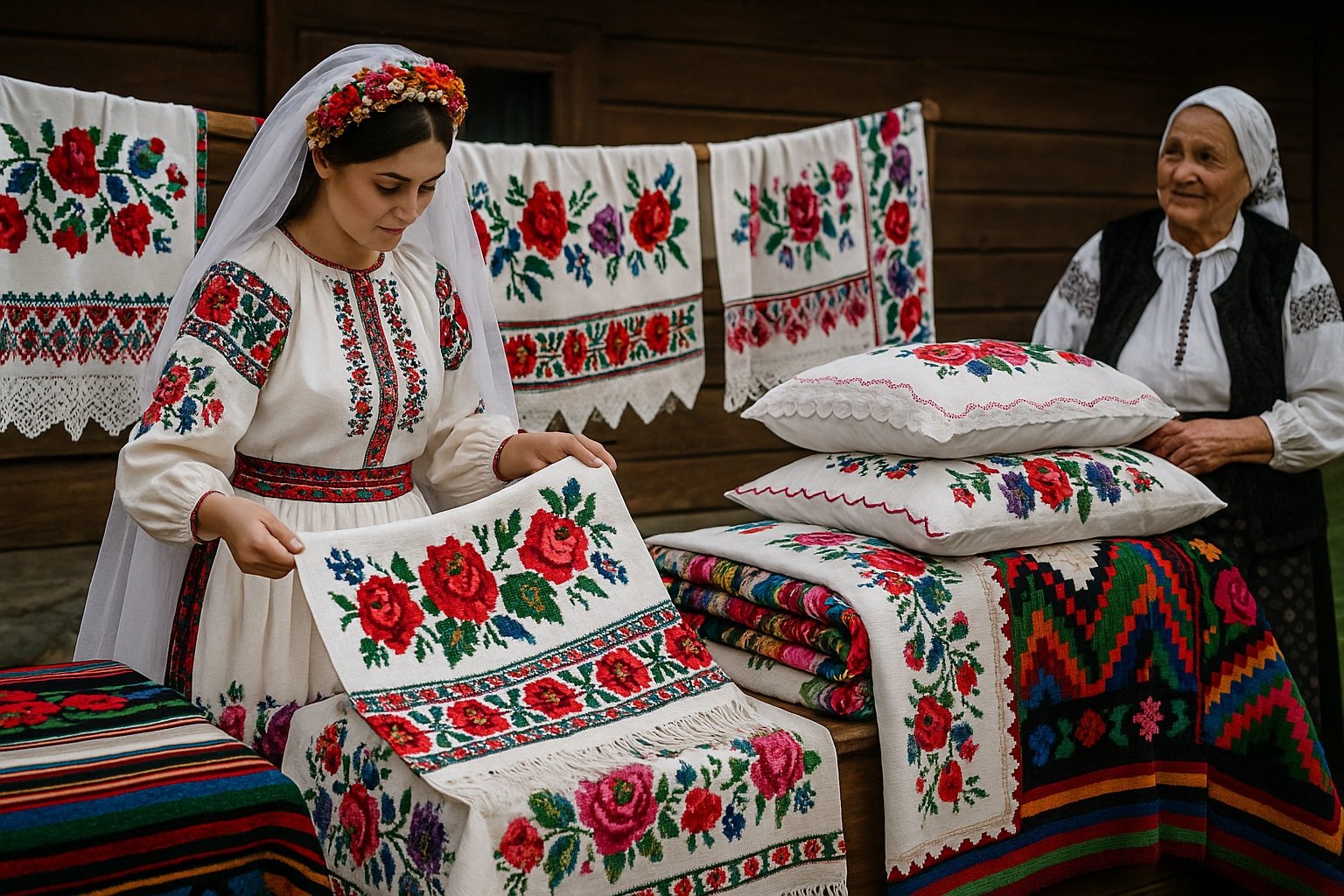
One of the most traditional and pride-filled moments in Romanian weddings is the “dowry display.” In this ritual, handmade items meticulously prepared over the years by the bride’s family are presented to the guests. The dowry typically includes embroidered tablecloths, bedding sets, towels, traditional clothing, and lacework. Each item reflects both the family’s material wealth and the bride’s skill and readiness. This display is not just a presentation, but also a matter of prestige for the bride’s mother and female relatives.
The dowry is usually showcased the day before the wedding or on the wedding morning, with the participation of guests. Items are taken out of carefully prepared chests and displayed in front of the house or at the wedding venue, decorated with colorful ribbons. Guests admire the items and offer compliments to the family. This tradition symbolizes the value placed on craftsmanship in Romanian culture and the pride a family feels for their daughter. It is also a meaningful ceremony that bridges the past and present, keeping cultural continuity alive.
First Dance and Money-Gifting Ritual: A Symbol of Prosperity and Abundance
In Romanian weddings, the couple’s first dance is not just a romantic moment but also an important ritual symbolizing the beginning of their new life together. This special dance typically takes place later in the celebration, with all guests gathering around and cheering the couple on with applause. The chosen music is often a meaningful folk tune or an emotional song that reflects the couple’s story. This moment represents the couple’s first steps together and is seen as a wish for a marriage filled with unity, harmony, and love.
Following the first dance comes the “money-gifting” ritual, one of the most joyful and supportive parts of the wedding. Guests express their wishes for abundance and prosperity by pinning money to the dancing couple or placing it on a special tray. In some regions, money is placed in the bride’s shoe, or guests make small donations to dance with the bride and groom. This tradition not only offers financial support to the newlyweds but also reflects the culture of solidarity and sharing within the community. Both symbolic and practical, this ritual enhances the joy of the wedding while strengthening the sense of cultural unity.
Animal Gifting Tradition in Village Weddings: A Symbolism Connecting to the Past
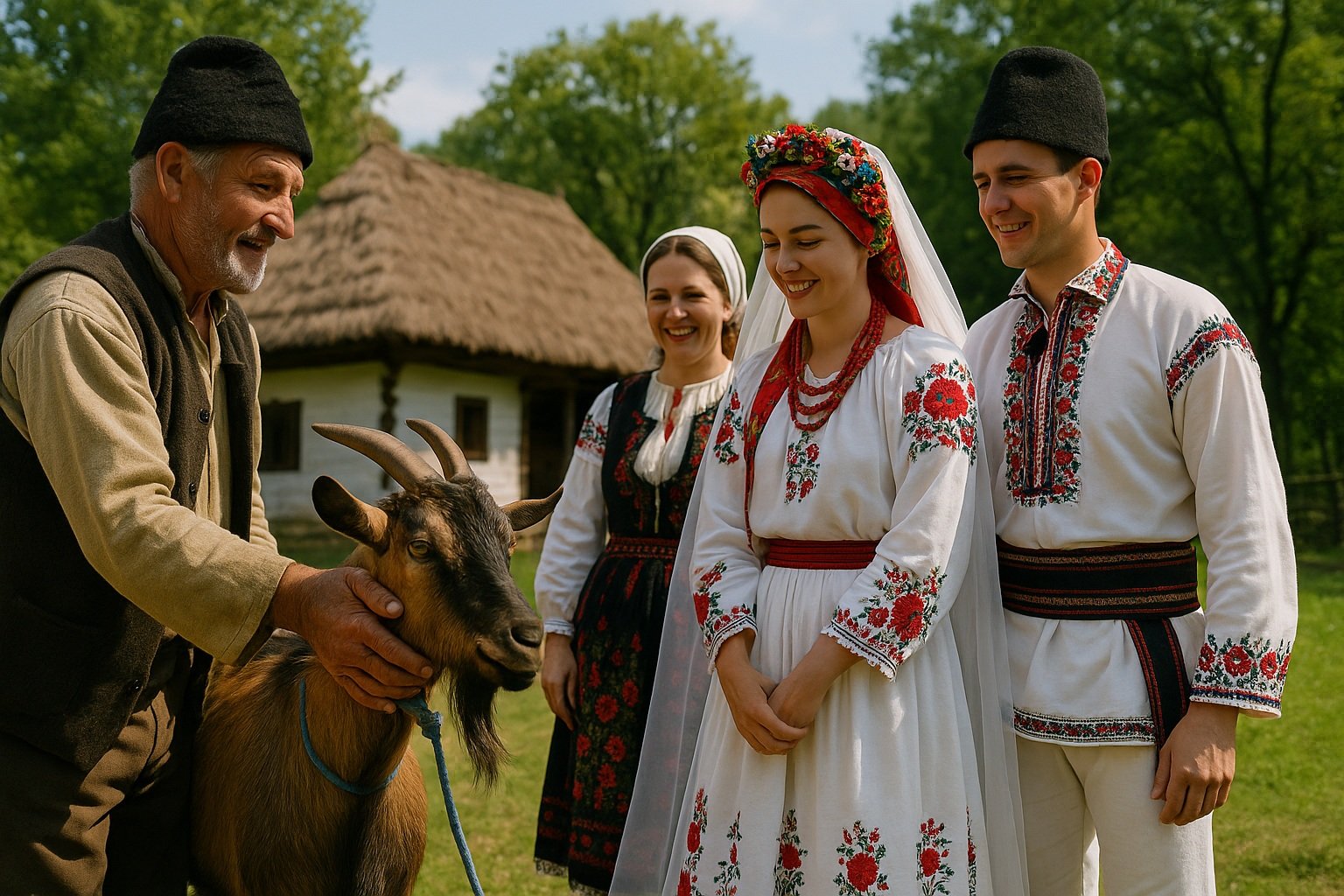
One of the oldest wedding traditions still preserved in rural areas of Romania is the ritual of gifting animals to the newlywed couple. This practice typically involves presenting farm animals such as sheep, goats, chickens, or sometimes a calf to the bride’s or groom’s family. The animals are given as both economic support and a wish for the new family to have a prosperous and productive life. In the past, such gifts were also seen as an expression of belief that the couple would work together to sustain their household.
This tradition carries not only material value but also reflects Romania’s cultural heritage deeply rooted in agriculture and livestock. In village weddings, the ceremonial presentation of animals becomes a source of joy and humor among guests, while also forming a symbolic bridge between past and present. Although now rarely seen due to modernization, the tradition is still kept alive in some villages, adding a nostalgic and local atmosphere to weddings. This ritual serves as a reminder of the community’s strong bond with nature and production.
